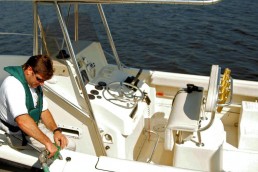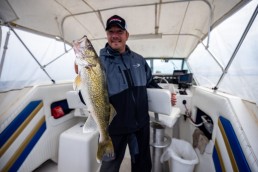Boater’s Pre-trip Checklist
SHARE THIS POST
Every boater should have a pre-trip checklist to review before hitting the road. Included should be verification of items like tools, spare fuses, duct and electrical tape, butt splice wire connectors, battery fluid and charge level, fuel additive and oil as needed for the outboard plus a spare tire and trailer jack.
There are other significant checklist categories to help prevent accidents and breakdowns.
Breakdown prevention
The pre-trip checklist should include a visual and physical check of the trailer’s winch and strap, bow and transom tie- downs, license plate, lights, brake fluid and pads, if so equipped, tire condition and proper air pressure.
According to Trailer Life Magazine: “Flat tires and blowouts are among the most common breakdown problems.” Fortunately, the air pressure in trailer tires can be monitored with a Tire Pressure Monitoring system (TMP). It works like the one on your car or tow vehicle only its sensors mount on each tire’s valve stem. The sensors transmit information to a receiver mounted inside the tow vehicle.
There are several manufacturers for this amazing trailer accessory and include Dill (under $500, six tires), Doran (under $200, two tires), HawksHead (about $339, four tires), Hopkins (under $300, four tires), plus others.
Another major reason for breakdowns while towing is wheel-bearing failure. Hopefully, your grease-style wheel bearings were serviced last fall to inspect, remove residual water and to install new water-resistant grease. If so equipped, oil bath bearings need a visual check for the correct amount of oil and to ensure lubricant is not cloudy, indicating water infiltration.
A top reason for on-the-water breakdowns is fuel quality. Today’s gasoline, which is usually 10 percent ethanol, can break down in as little as 30 to 60 days. While no additive can rejuvenate “gasohol,” additives like STA-BIL Ethanol Treatment or Lucas Safeguard Ethanol Fuel Conditioner with Stabilizers can help prevent dreaded issues, such as phase separation.
Safety
The U.S. Coast Guard (USCG) classifies life jackets or PFDs as Adult, Youth, Child and Infant, Type I through V, “Throwable with Inherent Buoyancy” from 7 pounds to 32 pounds. An Adult Type I is USCG-rated at 22 pounds of buoyancy.
Are you enjoying this post?
You can be among the first to get the latest info on where to go, what to use and how to use it!
But but how can a life jacket with this rating keep either a 20-pound anchor or a 200-pound person afloat?
Here is the math: A life jacket rated at 22 pounds of buoyancy floats a 200-pound person because our bodies are typically 80 percent water, negating 160 pounds of weight, and leaving 40 pounds for the PFD to float. However, the human body averages 15 percent fat, which is lighter than water and negates another 30 pounds, leaving only 10 pounds of buoyancy needed to float our 200-pound example.
Fortunately, manufacturers normally rate life jackets by age class and weight for children such as “Infant” or “Youth 50 To 90 Pounds,” etc., while adult’s are rated “Adult Small, Medium, Large, Extra Large,” etc., freeing us from the task of doing the above math. But all this is useless information if life jackets are stowed instead of worn or if they are defective. According to 2015 USCG statistics where cause of death “was known,” 76 percent of fatal boating-accident victims drowned. Of those drowning victims, 85 percent were not wearing a life jacket. At least once each season life jackets must be inspected for wear, rot, mold, crushed foam, defective snaps or frayed straps. Inspect inflatable models for the same issues plus “green” checkpoints, and then correct any problems.
Next, the first trip of the year and each trip after that should include a check of the boat’s fire extinguisher(s) to ensure sufficient fill. Each passenger should locate the extinguishers and understand their operation. According to BoatUS, boaters usually have “less than three minutes to extinguish a fire before having to abandon ship.”
Both the U.S. Coast Guard Auxiliary and the United States Power Squadrons have certified vessel examiners who will perform a free Vessel Safety Check (VSC) at your boat, at a time of mutual convenience. There is no charge and no consequences if you do not pass. Their goal is to help make boating as safe as possible. An inspection request form for personal pleasure craft is available at wow.uscgaux.info/. Boat owners can also take an anonymous online virtual safety check at wow.uscgaux.info/.
Finally, and most important, is boater education. According to the 2015 USCG statistics, of the 5,560 boating accidents in that year, 65 percent of the operators had no formal boating safety course. This includes a small number where their training was unknown. The most alarming statistic for this group is that they accounted for 89 percent of the boating deaths.
The data speaks for itself, and safety courses can help reduce accidents.
MWO
SHARE THIS POST
Did you enjoy this post?
You can be among the first to get the latest info on where to go, what to use and how to use it!
Darrell Taylor
Darrell Taylor has fished for more than 65 years. During the past 25 years, Taylor has generated more than 2,000 published articles, columns and fishing reports. His writings received 14 peer-level awards from outdoor writer organizations, including the Association of Great Lakes Outdoor Writers “Excellence in Craft” Golden Glow Award, their highest recognition.



